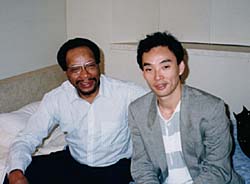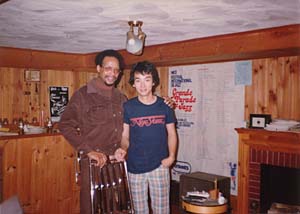

Alan & I

And the beat goes on!
Alan Dawson will be rememberd not only for his talents,
but for the skills he helped develop in many of today's leading drummers.
Alan Dawson
1929年7月14日ペンシルバニア州マリエッタ生まれ。1957年から1975年までバークリ−音学院で教職につく傍ら、デイブ・ブルーべック、フィル・ウッズ、らと共演。1975年、椎間板ヘルニアを患い音学院を退職後は、レキシントンの自宅地下のスタジオにて、積極的に後進の育成に勤めた。トニ−・ウイリアムス、ハービー・メイソン、ヴイニー・カリウタ、ステイーブ・スミス、ケニー・アーノフ、シンデイ・ブラックマン…………、を始めたくさんの有能なドラマーを世に送りだした。
先生のメソッドは、まさに教育現場における実体験の集大成であった。指導した多くの生徒達がかかえる、さまざまな悩み、問題、の解決策こそが、アメリカの約70%以上のドラマーが直接あるいは間接的に影響を受けタとされる、いわゆる『アラン・ド−ソン・メソッド』の神髄であった。日本においても、100ゴールデン・フィンガーズ・コンサート、Great Jazz Trio…….等のメンバーとして何度も来日、オフの時間を利用し、ドラム・クリニック、グループ・レッスン、ときにプライベート・レッスンを行い、積極的に教育活動を展開した。
1995年5月、来日直前に病気が発覚。白血病であった。入退院をくり返し、病と闘ったが、1996年2月23日自宅にて帰らぬ人となった。享年66歳。
それにしても、あのいつも絶やす事のなかった笑顔は一体どこから生まれるのか………….。反面「この薬を服用していれば、あの名手シェリー・マンも助かったのに………。」と話しながらいつも薬を離さずに、長期間病と闘っていた。
Preface.
Mr. Alan Dawson will always be remembered not only for histalent, but for the skills he has taught to drummers of today.
Alan Dawson was born on July 14, 1929 in Marietta, Pennsylvania. Alan had recorded with such greats as Booker Ervin, Dave Brubeck,Lionel Hampton, Quincy Jones, George Benson, Clifford Brown,Jaki Byard, and many more. He had traveled extensively in Japan,as well as to Europe, Australia, and throughout Asia. In 1957, hestarted his teaching career at The Berklee College of Music andhad taught for over 18 years. In 1975, Alan had injured himself byrupturing a his disc in his back and had required surgery. He hadstopped his teaching career at Berkee and continued teaching fromhis home.
His teaching method is legendary and was considered a fruit fromhis actual playing experience in the field of education. By solvingconcerns and personal problems in drumming, which had affectedalmost over 70% of drummers, this was resolved by following hiscore teaching called the "Alan Dawson Technique."
When he went on concert tours in Japan, as a member of the100 Golden Fingers Concert and Great Jazz Trio, he spent hisprivate time giving lessons. Right before departing for Japanin May 1995, he learned that he had leukemia. After a longstruggle with this disease, he died of leukemia at home onFebruary 23, 1996 at the age of 66.
It always made me wonder what made him always have thisperpetual smile. What made him always so happy and glad? Fighting through his illness for an extended period of timewith medication, he said that he kept on saying, "This couldhave helped Mr. Shelly Manne."
Alan taught Tony Williams, Keith Copeland, Steve Smith,Harvey Mason, Vinnie Colaiuta, John Robinson,Kenny Aronoff, and many, many others.
FOREWORD
The Memory of Alan Dawson
 私が初めてアラン・ドーソン先生に習ったのは、1975年6月14日土曜日夕方の3時からだった。あまりに最初のレッスンが衝撃的であったので、今でもその時のことは覚えている。
私が初めてアラン・ドーソン先生に習ったのは、1975年6月14日土曜日夕方の3時からだった。あまりに最初のレッスンが衝撃的であったので、今でもその時のことは覚えている。
当時19歳の私は、アランに習うことで天才トニー・ウィリアムスになれるんだという、夢が実現したような、最高の気分であった。アラン・ドーソン、イコールあの天才トニーを教えた先生としか頭の中にはなかった。
ところで、アランの家まで行くのが大変なことで、まずバスでハーバード・スクエア終点まで行き、そこでアーリントン・ハイツ行きのバスに乗り換え、またまた終点まで行き、最後にレキシントン行きのバスでメイプル・ストリートで降りる。このメイプル・ストリートはバス停なんてとても呼べるものではなく、ただ1本の木の柱にペイントでマークされているだけ。もちろん、あらかじめ車掌に伝えておかないと、停まってもらえない…そういうバスストップであった。
とにかく、無事に下車すると、もうこの辺りは森の中の大邸宅ばかり。目指すアランの家は、バス・ストップからさらに徒歩で20〜30分くらい歩いた所にある大きな白い家であった。地下に彼のスタジオがあり、案内されて早速レッスンということになった。
初めて受けたレッスンは、レッスンというよりオリエンテーションというべきもので、私が今までどのような勉強をしてきたかをチェックすることから始まった。
最初にシングル・ストローク、ダブル、パラディドルを、すべてパッドを使ってメトロノームを使わずゆっくりから徐々にアップ、そしてまた元のスロー・テンポに戻る。ここまでは順調で、淡々と進んで行った。次にアランが“何かスタンダードを歌ってみろよ”と私に要求した。私は“エッ…!”とビックリして、聞き返した。トニー・ウィリアムスのフレーズを習いにレッスンを受けに来たのに、歌を歌え…!そんなことをこの大先生の前でやったら、日本のハジだ…と思った途端、私の体はガチガチの緊張状態となった。しかし、アランは一向に気にする様子もなく“ヤァー歌ってみろよ…「サテンドール」なんかどうだい”と曲まで指定してきた。当然、私はパニック状態となった。アランはその後ずっとスタンダードのメロディを歌いながら、ドラムの課題をこなしていくという宿題を与え続けた。そして、たとえドラムの課題がバッチリできても、曲の構成(フォーム)“AABA”、サビの位置、小節数を間違えると間違えると、それだけでやり直しをさせられた。アランはいつでもドラミング(リズム)とメロディを一緒に考えていた。それゆえに代々、彼の生徒はたくさんのスタンダード曲を正しいフォームで歌えるように、準備することが必要であった。
もう一つ例を出すと、たとえばドラムセットで何かの課題を1人で練習していたとして、たいていの人は途中で間違えると“先生、もう一度最初からやり直させてください”と言うだろう。アランはそういう時でも“君はいつでもバンドと演奏していることを想定して練習しなければだめだよ”と話してくれた。つまりバンドと一緒にプレイしていたら、たとえ自分が間違えても、曲を止めることはできない。ましてや人前での演奏ならなおさらだ。彼はそういうことをシミュレーションさせていた。
ところで、私がどれだけゴキゲンに「サテンドール」を歌ったかはアラン先生のみが知っている。私は極度の緊張状態だったので、覚えていない。
次にリーディングを有名なTed Reed Bookを使って試された。幸い私はピアノを勉強していたので譜面は読めた。ところが、アラン先生は“大きな声を出してカウントしてごらん…”と要求した。私は完全にギブアップ。カウントの数え方もオルタネートの手順というのも、理解していなかった。
1975年6月14日、私は初めてアランのメソッドに接した。そして、この後の血と汗と涙の4年間は、今となってはすべて最高の思い出に変わった。
FOREWORD
The Memory of Alan Dawson.
I had my first lesson with Alan Dawson at three in the afternoon on Saturday, June 14th,1975. The first lesson had such a big impact on me that I remember it very well to this day.
I was nineteen at the time and feeling real good, like a dream had come true, thinking that I could become like Tony Williams by taking lessons from Alan Dawson. My only impression of Alan Dawson was that he was the teacher of the great Tony Williams. However, it was no easy task just getting to Alan's house. First I had to catch a bus and take it to the last stop at Harvard Square. Then I had to get on another bus and ride it all the way to Arlington Heights. There I would catch yet another bus headed for Lexington and ride it to Maple Street. There was no bus stop at Maple Street, only a tree marked with some paint. You had to tell the driver that was your stop, otherwise he'd just keep driving past it. That's the kind of bus stop it was.
Anyway, when I finally made it to the bus stop, there were nothing but big houses surrounded by forests. Alan's house was a big white mansion another twenty or thirty minutes walk from the bus stop. His studio was in the basement, where I was led for my first lesson.
My first lesson was more like an orientation, where Alan checked what kind of studying I had done up to then.
We started with single stroke rolls, double stroke rolls, and paradiddles on a pad without using a metronome. First slow, gradually faster, and back to the original slow tempo. I was doing these fine, when Alan suddenly told me to "Sing a standard ". I said " What? " and it totally threw me off.
I was there to learn Tony Williams phrases, and he wanted me to sing !! NO WAY! I started to worry about becoming an embarrassment in front of this world- renowned teacher and became nervous and tense. However, Alan paid this no mind, and said
" Come on, sing How about 'Satin Doll' ?"
Man, I panicked.
Alan then told me that I should always sing the melody of a standard when working on drum exercises. Even if I had the drumming exercise down, Alan made me do the song over if I didn't have the form…(AABA), location of the bridge, and number of bars right. Alan always thought of drumming (rhythm) and melody together. All of his students had to learn to sing a great number of standard tunes in the right form.
To give another example, when a student would be working on an exercise alone on the kit, every time they would make a mistake, they'd say "let me start over." However, whenever this happened, Alan would say "you have to practice as though you're playing with a band,"…..meaning that even if you make a mistake, the song goes on. This is especially true if you're playing to an audience. Alan always make his students keep this in mind.
By the way, Only Alan knows how well I sang "Satin Doll " that day. I was so nervous I don't remember.
Next, Alan tested my reading using the famous Ted Reed book. Fortunately, I had studied piano so I could read. However, Alan's next request was to " count out look in a loud voice." I was completely stumped. I didn't know anything about counting or alternate sticking.
On June 14th.1975, I had my first encounter with Alan's method. The next four years were filled with frustration, hard work, and a great sense of accomplishment.
TODAY THEY ARE MY GREATEST MEMORY.

